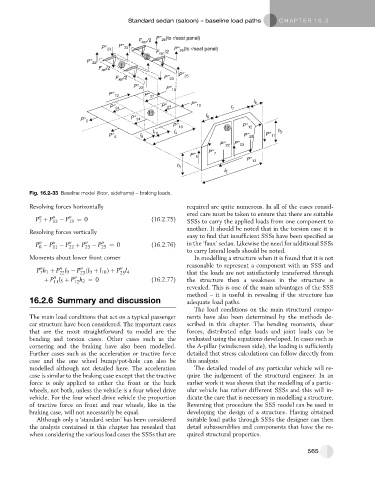Page 556 - Automotive Engineering Powertrain Chassis System and Vehicle Body
P. 556
Standard sedan (saloon) – baseline load paths C HAPTER 16.2
Fig. 16.2-33 Baseline model (floor, sideframe) – braking loads.
Resolving forces horizontally required are quite numerous. In all of the cases consid-
ered care must be taken to ensure that there are suitable
00
P þ P 00 12 P 00 13 ¼ 0 (16.2.75) SSSs to carry the applied loads from one component to
7
another. It should be noted that in the torsion case it is
Resolving forces vertically
easy to find that insufficient SSSs have been specified as
00
P P 00 11 P 00 22 þ P 00 23 P 00 25 ¼ 0 (16.2.76) in the ‘faux’ sedan. Likewise the need for additional SSSs
6
to carry lateral loads should be noted.
Moments about lower front corner In modelling a structure when it is found that it is not
reasonable to represent a component with an SSS and
00
00
00
00
P h 1 þ P l 9 P ðl 9 þ l 10 Þþ P l that the loads are not satisfactorily transferred through
25 4
7
22
23
00
00
þ P l 5 þ P h 2 ¼ 0 (16.2.77) the structure then a weakness in the structure is
11
12
revealed. This is one of the main advantages of the SSS
method – it is useful in revealing if the structure has
16.2.6 Summary and discussion adequate load paths.
The load conditions on the main structural compo-
The main load conditions that act on a typical passenger nents have also been determined by the methods de-
car structure have been considered. The important cases scribed in this chapter. The bending moments, shear
that are the most straightforward to model are the forces, distributed edge loads and joint loads can be
bending and torsion cases. Other cases such as the evaluated using the equations developed. In cases such as
cornering and the braking have also been modelled. the A-pillar (windscreen side), the loading is sufficiently
Further cases such as the acceleration or tractive force detailed that stress calculations can follow directly from
case and the one wheel bump/pot-hole can also be this analysis.
modelled although not detailed here. The acceleration The detailed model of any particular vehicle will re-
case is similar to the braking case except that the tractive quire the judgement of the structural engineer. In an
force is only applied to either the front or the back earlier work it was shown that the modelling of a partic-
wheels, not both, unless the vehicle is a four wheel drive ular vehicle has rather different SSSs and this will in-
vehicle. For the four wheel drive vehicle the proportion dicate the care that is necessary in modelling a structure.
of tractive force on front and rear wheels, like in the Reversing that procedure the SSS model can be used in
braking case, will not necessarily be equal. developing the design of a structure. Having obtained
Although only a ‘standard sedan’ has been considered suitable load paths through SSSs the designer can then
the analysis contained in this chapter has revealed that detail subassemblies and components that have the re-
when considering the various load cases the SSSs that are quired structural properties.
565

